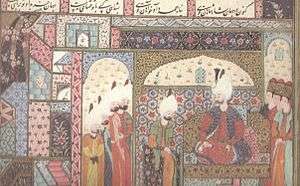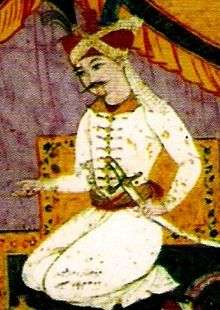Safavid Shirvan
The Shirvan province (Persian: ولایت شیروان, romanized: Velāyat-e Shirvān) was a velayat (province) founded by the Safavid Empire on the territory of modern Azerbaijan and Russia (Dagestan) between 1501 and 1736 with its capital in the town of Shamakhi.[1]
Shirvan Velāyat-e Shirvān ولایت شیروان | |||||||||
|---|---|---|---|---|---|---|---|---|---|
| 1501–1736 | |||||||||
_-_Geographicus_-_Persia-delisle-1724._G.jpg) | |||||||||
| Status | Province of the Safavid Empire Under Ottoman occupation (1583–1607) | ||||||||
| Capital | Shamakhi | ||||||||
| Common languages | Persian, Azerbaijani | ||||||||
| Government | Velayat | ||||||||
| Beglarbeg | |||||||||
| History | |||||||||
• Establishment | 1501 | ||||||||
• Disestablished | 1736 | ||||||||
| |||||||||
| Today part of | |||||||||
The province had six administrative jurisdictions; Alpa'ur, Arash—Shaki, Baku, Chemeshgazak—Agdash, Derbent (Darband), Quba—Qolhan, and Saliyan.[2] The capital of Shamakhi had a separate governor, but is not mentioned by the then contemporary historians and geographers to have formed a separate administrative jurisdiction.[2]
Control over Shirvan was firmly held by the Safavids from the time of the subjugation of Shirvan (except for several brief Ottoman intermissions) when eventually the Afsharid ruler of Iran, Nader Shah established firm rule over the area until the area. After his death, the area was divided into various subordinate various khanates, before they were conquered by the Russian Empire from Qajar Iran in the course of the 19th century.[3]
History
Having ended the rule of the Shirvanshahs in 1538, Tahmasp I established Shirvan as an administrative unit of the empire. At the end of the 16th century, the Ottoman General Lala Kara Mustafa Pasha briefly captured Shirvan during the Ottoman-Safavid War (1578-1590) and appointed Özdemiroğlu Osman Pasha as its governor. In 1607, Shah Abbas I invaded Shirvan again and instituted Qizilbash rule over the province. After several interstate wars, Shirvan was eventually captured by Nader Shah in 1734 to establish Safavid rule over the province again.[1][4]
List of governors


| Date | Governor |
|---|---|
| 1501 | Bahram Beg* |
| 1501-1502 | Gazi Beg* |
| 1502 | Sultan Mahmud* |
| 1502-1509 | Ibrahim II Shaykhshah* |
| 1509-1519 | Hossein Beg Laleh |
| 1519-1524 | Ibrahim II Shaykhshah* |
| 1523-1535 | Khalilullah II* |
| 1535-1538 | Shahrukh* |
| 1538-1547 | Alqas Mirza |
| 1538-1541 | Badr Khan Ustajlu |
| 1538-1543 | Ghazi Khan Tekkelu |
| 1543-1547 | Badr Khan Ustajlu |
| 1547-? | Ismail Mirza |
| 1547-1549 | Shahverdi Sultan |
| 1548-1550 | Burhan Ali*§ |
| 1549 | Mehrab Mirza*§ |
| 1549-1550 | Qorban Ali Mirza*§ |
| 1554 | Qasem Mirza*§ |
| 1549-1565 | Abdollah Khan Ustajlu |
| 1566 | Mostafa Beg |
| 1566 | Shah Beg Ali |
| 1567 | Farrokhzad Beg Qaradaghlu |
| 1567-1576 | Aras Khan Rumlu |
| 1577 | Abu Torab Soltan Ustajlu |
| 1577 | Kavus Mirza*§ |
| 1577 | Aras Soltan Khan Rumlu |
| 1578 | Abu Bakr Mirza*§ |
| 1578 | Panah Mohammad Khan Dhu'l-Qadr |
| 1578-? | Mohammad Khan Khalifeh Hajjilar Dhu'l-Qadr |
| 1579 | Suleiman Khan Ustajlu |
| 1580-1583 | Peykar Beg Khan Ziyadoghlu |
| 1583 | Khalifeh Ansar Qaradajlu |
| 1604–05 | Constantine I of Kakheti |
| 1583-1607 | Ottoman occupation |
| 1610-1624 | Yusuf Khan |
| 1624-1633 | Qazaq Khan Cherkes |
| 1643–1653 | Khosrow Soltan Armani |
| 1653 | Najafqoli Khan Cherkes |
| 1663–67 | Najafqoli Khan Cherkes |
| 1718 | Hasan-Ali Khan Daghestani |
See also
- Shirvan
- Shirvan (city)
- Shirvan, Iran
References
- Khalilli, Fariz (2009). ŞAMAXI TARİX-DİYARŞÜNASLIQ MUZEYİ [Shamakhi Historical and Locality Museum]. Baku: ANAS. p. 103. Retrieved 2011-08-08.
- Nasiri, Ali Naqi; Floor, Willem M. (2008). Titles and Emoluments in Safavid Iran: A Third Manual of Safavid Administration. Mage Publishers. p. 284. ISBN 978-1933823232.
- Afandiyev, O. A. (1993). Azərbaycan Səfəvilər dövləti [Safavid state of Azerbaijan]. Baku. p. 57.
- Fleischer, Cornell H. (1989). Mustafa Ali and the Politics of Cultural Despair. Cambridge University Press.
Sources
- Floor, Willem M. (2008). Titles and Emoluments in Safavid Iran: A Third Manual of Safavid Administration, by Mirza Naqi Nasiri. Washington, DC: Mage Publishers. pp. 1–337. ISBN 978-1933823232.CS1 maint: ref=harv (link)